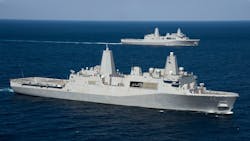Raytheon prepares to build AN/SPY-6 radar systems for aircraft carriers and amphibious transport ships
WASHINGTON – Surface warship radar experts at the Raytheon Co. are preparing to build two advanced shipboard air-defense radar systems -- one for a late-model San Antonio-class amphibious transport dock (LPD), and the other for a new-build Ford-class aircraft carrier.
Officials of the U.S. Naval Air Systems Command in Washington announced a $40.2 million order Tuesday to the Raytheon Integrated Defense Systems segment in Marlborough, Mass., to provide long-lead items to build two AN/SPY-6(V) configuration radar variants -- the SPY-6(V)2 rotator radar and the SPY-6(V)3 fixed-face radar.
These two surface warship radar systems are part of the Raytheon Enterprise Air Surveillance Radar (EASR) project -- the newest sensor in the Navy’s SPY-6 family of radars. It is the Navy’s next generation radar for aircraft carriers and amphibious warfare that provides simultaneous anti-air and anti-surface warfare, electronic protection and air traffic control.
Long-lead items either are difficult and time-consuming to obtain, and are funded early in the aircraft design process to keep overall production on schedule. Contracts to build the missile will come later.
The AN/SPY-6 EASR radar delivers increased performance, higher reliability and sustainability, and lower total ownership cost than the radars they will replace. It capitalizes on scalable technologies of AN/SPY-6(V) Air and Missile Defense Radar (AMDR), in a tailored configuration carriers and amphibious ships.
EASR uses gallium nitride (GaN) technology for enhanced power, efficiency, size, weight, cost, and reliability; and performs digital beam forming and advanced algorithms for operating in high clutter environments with much electromagnetic interference. The radar also has built-in cyber resiliency, Raytheon officials say.
The new Navy Raytheon AN/SPY-6 has four versions. This order involves the AN/SPY-6(V)2 EASR in a rotated and scaled-down version with nine radar modular assemblies for Flight II San Antonio-class LPD ships; and the AN/SPY-6(V)3 fixed version of EASR for Ford-class aircraft carrier and future FFG(X) Navy frigates.
The two other versions are the AN/SPY-6(V)1 AMDR with 37 radar modular assemblies for flight III Arleigh Burke-class guided missile destroyers; and the AN/SPY-6(V)4 AMDR with 24 radar modular assemblies that will be retrofitted to Flight IIA Burke-class destroyers.
Related: Navy orders 12 advanced AN/SPQ-9B shipboard radar systems from Northrop Grumman
Raytheon prevailed over Northrop Grumman Corp. and Lockheed Martin Corp. to build the AN/SPY-6(V) in 2013. The surface warship radar system will provide greater detection ranges, increased discrimination accuracy, higher reliability and sustainability, and lower costs, compared to the AN/SPY-1D(V) radar onboard today’s Burke-class destroyers.
The AN/SPY-6(V) is built with individual building blocks called radar modular assemblies (RMAs), Raytheon officials say. Each RMA is a self-contained radar in a two-cubic-foot box; RMAs can stack together to form any size array to fit ship mission requirements.
The inherent scalability of the AN/SPY-6(V) also could enable new instantiations, such as backfits on existing Burke-class destroyers and installation on aircraft carriers, amphibious warfare ships, frigates, the littoral combat ship, and Zumwalt-class land-attack destroyers without significant new radar development costs, Raytheon officials say.
The AN/SPY-6(V) will have adaptive digital beam forming and radar signal processing for dealing with high-clutter and jamming environments. The AN/SPY-6(V) radar also is reprogrammable to adapt to new missions or emerging threats.
It uses high-powered gallium nitride (GaN) semiconductors, distributed receiver exciters, adaptive digital beam forming, and Intel processors for digital signal processing.
The new radar will feature S-band radar coupled with X-band horizon-search radar, and a radar suite controller (RSC) to manage radar resources and integrate with the ship’s combat management system.
On this order Raytheon will do the work in Marlborough, Mass., and should be finished by June 2020. For more information contact Raytheon Integrated Defense Systems online at www.raytheon.com, or Naval Sea Systems Command at www.navsea.navy.mil.
About the Author
John Keller
Editor-in-Chief
John Keller is the Editor-in-Chief, Military & Aerospace Electronics Magazine--provides extensive coverage and analysis of enabling electronics and optoelectronic technologies in military, space and commercial aviation applications. John has been a member of the Military & Aerospace Electronics staff since 1989 and chief editor since 1995.
